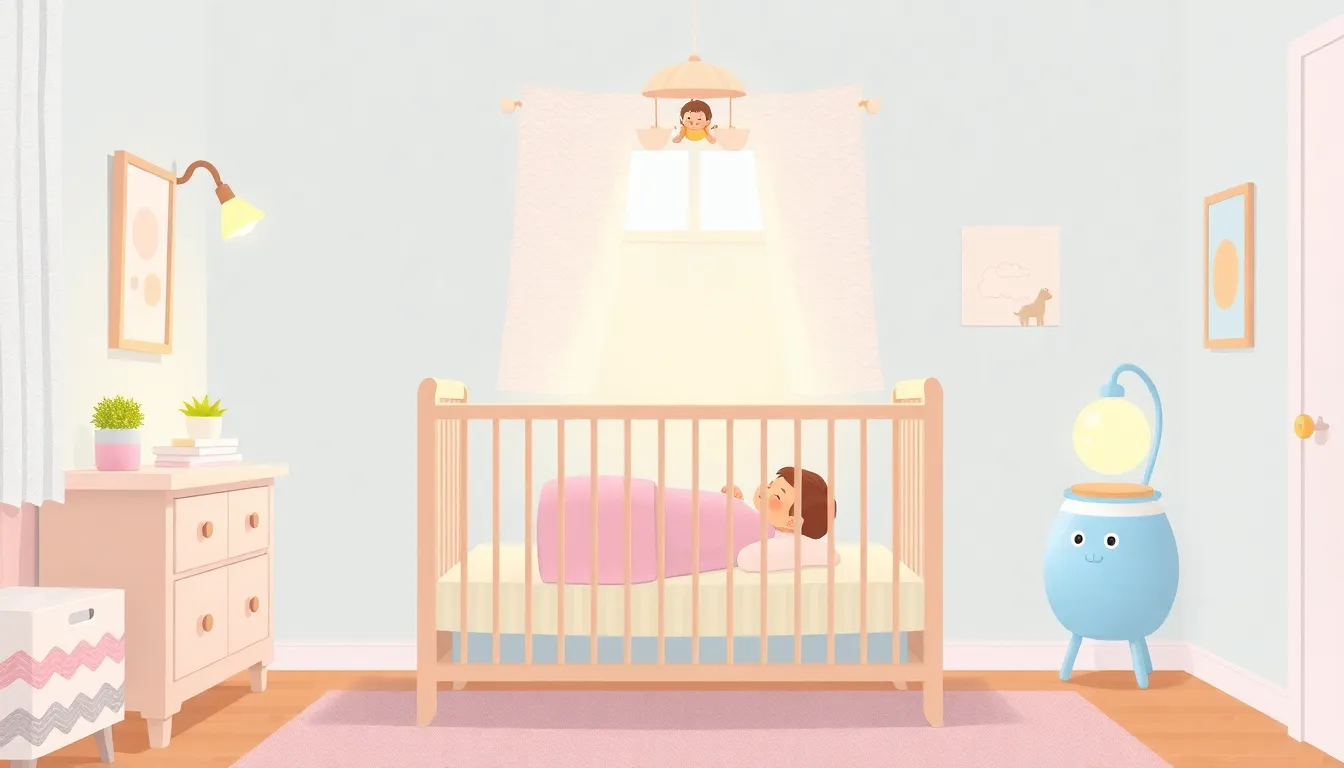Navigating the world of newborn sleep can feel like a never-ending game of peekaboo. Parents often find themselves wondering when their little bundles of joy will finally trade in those midnight cries for some peaceful slumber. Spoiler alert: there’s light at the end of the sleep-deprived tunnel!
As babies grow, their sleep patterns evolve, and understanding this journey can be a game-changer. From those early days of catnaps to longer stretches of sleep, knowing what to expect can help parents manage their sanity. So grab a cup of coffee (or two) and let’s dive into the fascinating timeline of baby sleep. After all, a well-rested baby means a well-rested parent—and who wouldn’t want that?
Table of Contents
ToggleUnderstanding Baby Sleep Patterns
Grasping baby sleep patterns helps parents set realistic expectations. Sleep habits evolve significantly during the first year.
Newborn Sleep Behavior
Newborns typically sleep 14 to 17 hours a day. They don’t differentiate between day and night, leading to frequent awakenings. Short sleep cycles of 50 to 60 minutes are common, and active sleep occurs during this time. During these periods, babies often exhibit twitching and rapid eye movement. Frequent feeding is essential as it supports their growth. Parents can expect their little ones to take short naps throughout the day and night, with some clustering toward early mornings.
Developmental Changes in Sleep
Around three months, babies start showing signs of consolidating their sleep. Sleep cycles gradually extend up to 3 to 4 hours. By four to six months, many babies sleep for longer stretches at night. They begin developing a circadian rhythm, leading to longer nighttime sleep. Parents may notice decreased night feedings as babies take in more calories during the day. Consistent bedtime routines can reinforce healthy sleep habits during this period, contributing to better sleep quality.
Factors Influencing Sleep Duration

Multiple factors contribute to the duration of a baby’s sleep. Understanding these elements helps parents navigate sleep challenges.
Age and Development Milestones
Babies reach significant developmental milestones that impact their sleep patterns. Around three months, changes in sleep cycles occur as infants start consolidating sleep. By four to six months, the development of a circadian rhythm typically begins. Increased awareness and physical activity influence a baby’s ability to sleep longer stretches. As they approach six months, many babies can often sleep for longer periods at night. Growth spurts may temporarily disrupt sleep, leading to variations in duration as the baby develops.
Feeding Patterns and Sleep
Feeding patterns greatly influence a baby’s sleep duration. Newborns frequently wake to feed, typically every two to three hours. As babies grow, they begin to space out feedings, which can result in longer sleep stretches. During the four to six-month phase, many infants can sleep longer at night without needing to feed. Consistency in feeding schedules can assist in regulating sleep patterns. Introducing solids may also impact feeding dynamics, further influencing overall sleep quality.
Tips for Encouraging Longer Sleep Stretches
Creating the right environment and routine promotes longer sleep stretches for babies.
Creating a Sleep-Friendly Environment
A dark room encourages melatonin production. Reducing light and noise enhances comfort. Room temperature should stay between 68 to 72 degrees Fahrenheit. Consider white noise machines to mask disruptive sounds. Soft, breathable bedding contributes to a cozy atmosphere. Ensure the crib is free from toys and blankets to minimize safety risks. Choose calming colors or decorations to promote relaxation. These adjustments create a peaceful space that fosters better sleep.
Establishing a Bedtime Routine
Routine helps signal bedtime to babies. Start with calming activities like a warm bath or gentle rocking. Reading a short story or playing soft music establishes familiarity. Aim for a consistent bedtime to reinforce the internal clock. Avoid stimulating activities close to bedtime, as they can interfere with falling asleep. Implementing a wind-down period prepares babies for restful sleep. Short, repetitive steps create a cue for sleep that babies learn to recognize over time.
Common Sleep Issues and Solutions
Parents often encounter sleep challenges as their babies grow. Addressing these issues promptly can lead to more restful nights.
Dealing with Sleep Regression
Sleep regression typically occurs around four months as babies undergo developmental changes. This phase may lead to increased night awakenings and shorter sleep stretches. Parents might notice their baby fights sleep or wakes more frequently. Expect this regression to last a few weeks before sleep patterns stabilize. Maintaining consistent bedtime routines can help ease the transition. Establishing a calming pre-sleep environment promotes better sleep.
Identifying Sleep Disorders
Recognizing sleep disorders in infants can be crucial for long-term health. Signs of potential issues include extreme difficulty falling asleep, persistent night awakenings, and excessive fussiness during the day. Parent observation of breathing irregularities, like pauses or snoring, warrants immediate attention. Consulting with a pediatrician about these concerns ensures proper evaluation. Diagnosis can lead to appropriate interventions and create a healthier sleep environment for the baby. Taking action early on can minimize disruptions for both baby and parents.
Understanding when babies start sleeping longer stretches can significantly ease the challenges parents face during those early months. As infants grow and develop, sleep patterns naturally evolve. By around three months, many babies begin consolidating their sleep, paving the way for longer periods of rest.
Establishing a consistent bedtime routine and creating a sleep-friendly environment can further enhance sleep quality. While sleep regressions may occur, maintaining these routines will help navigate the ups and downs of infant sleep. With patience and the right strategies, parents can look forward to more restful nights ahead.





